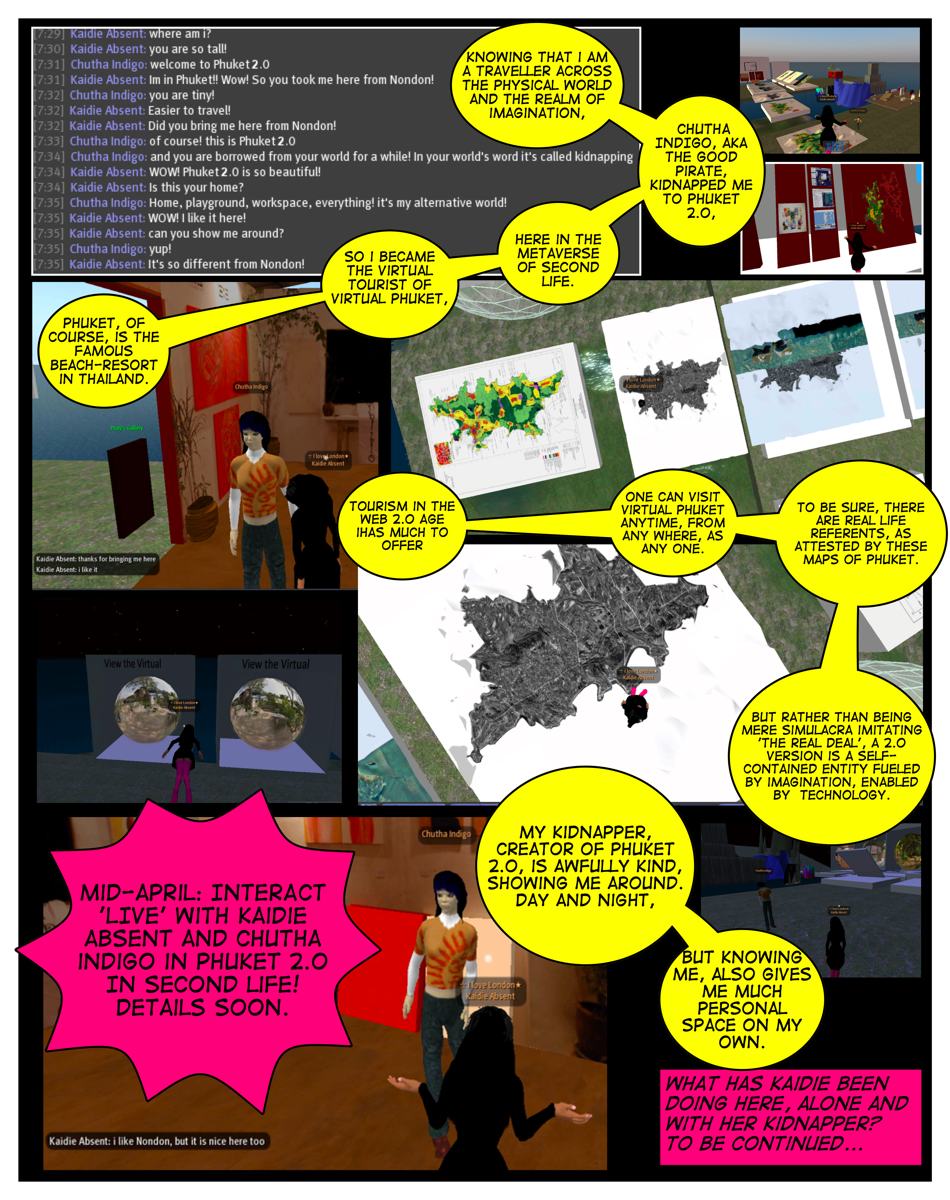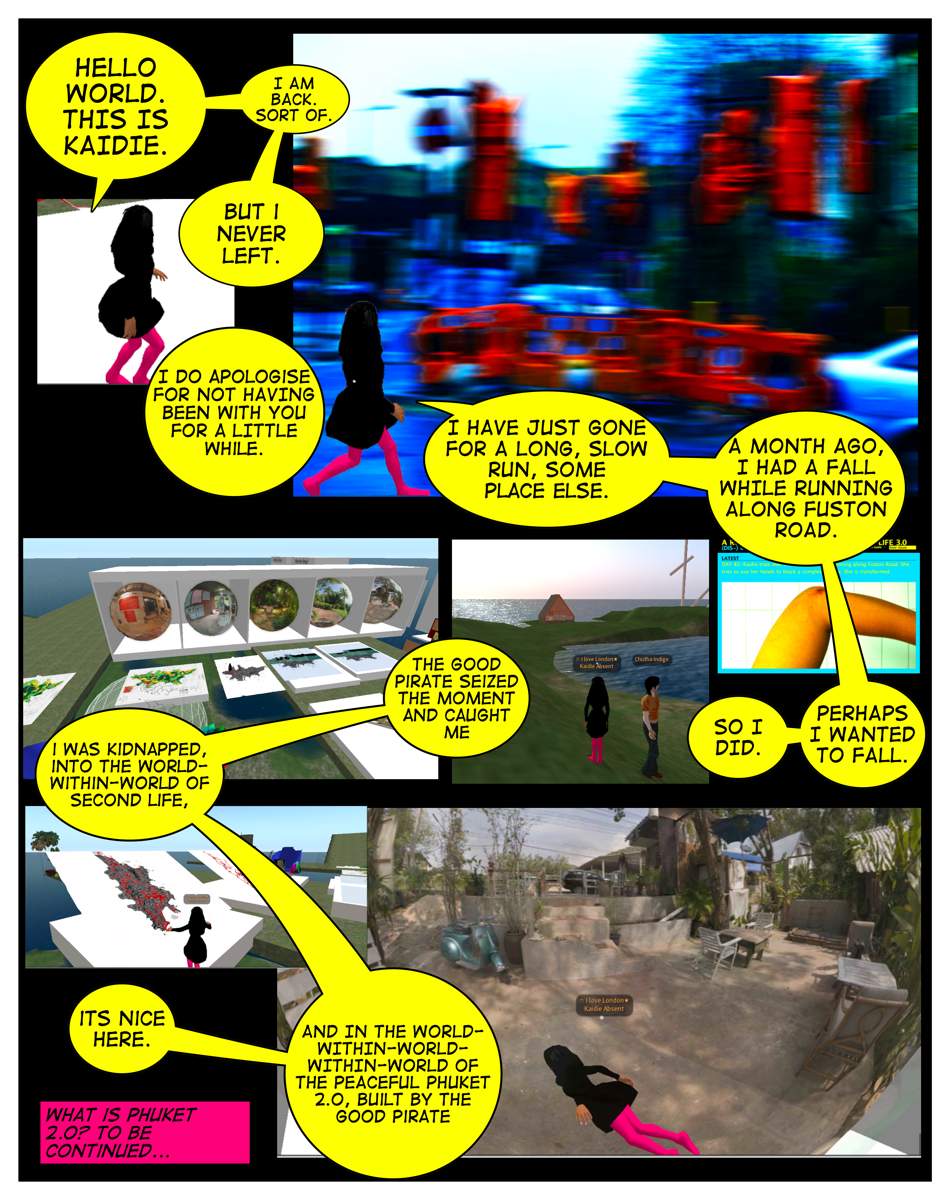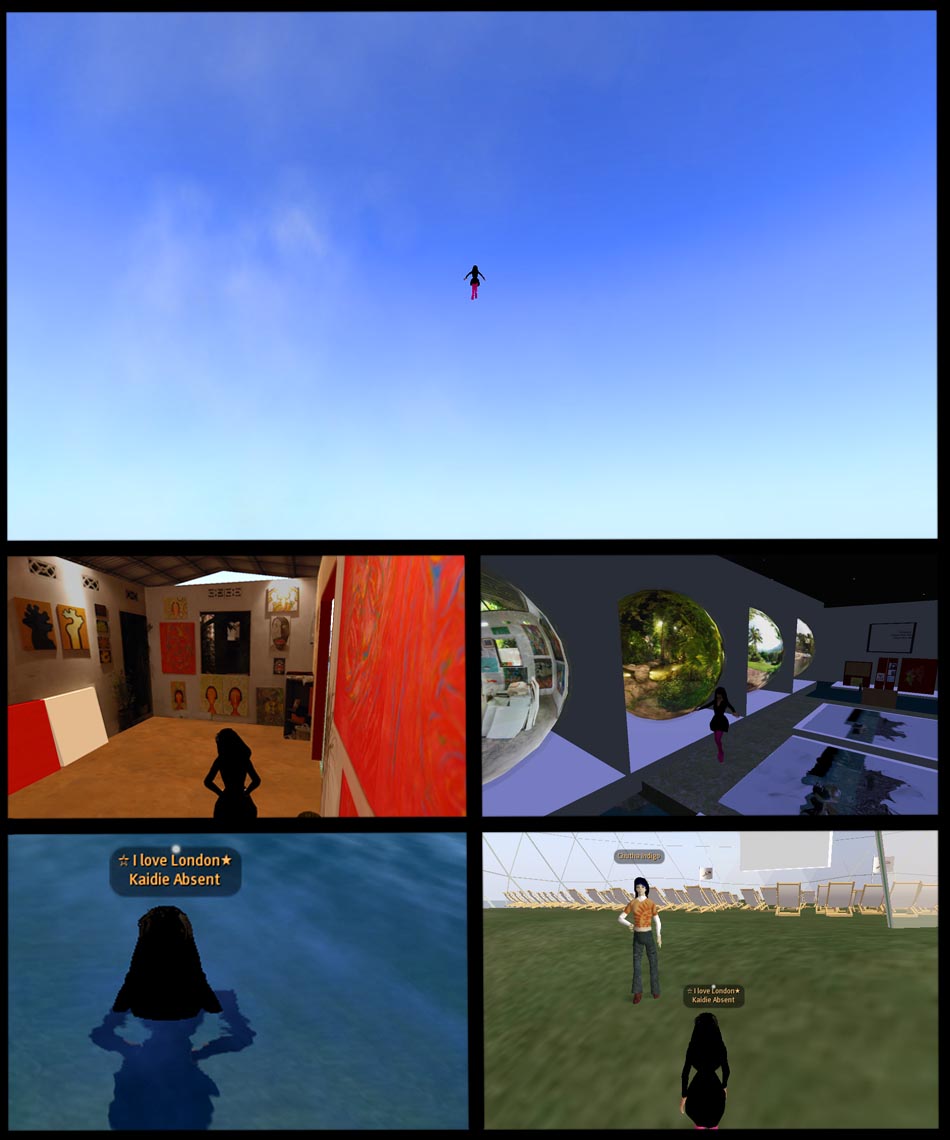WHERE IS THAT ‘SPACE’ IN CYBERSPACE? (HOW) DOES PHYSICS FUNCTION IN CYBERSPACE? Where did we come from? Where are we now? Where (the hell) are we off to?
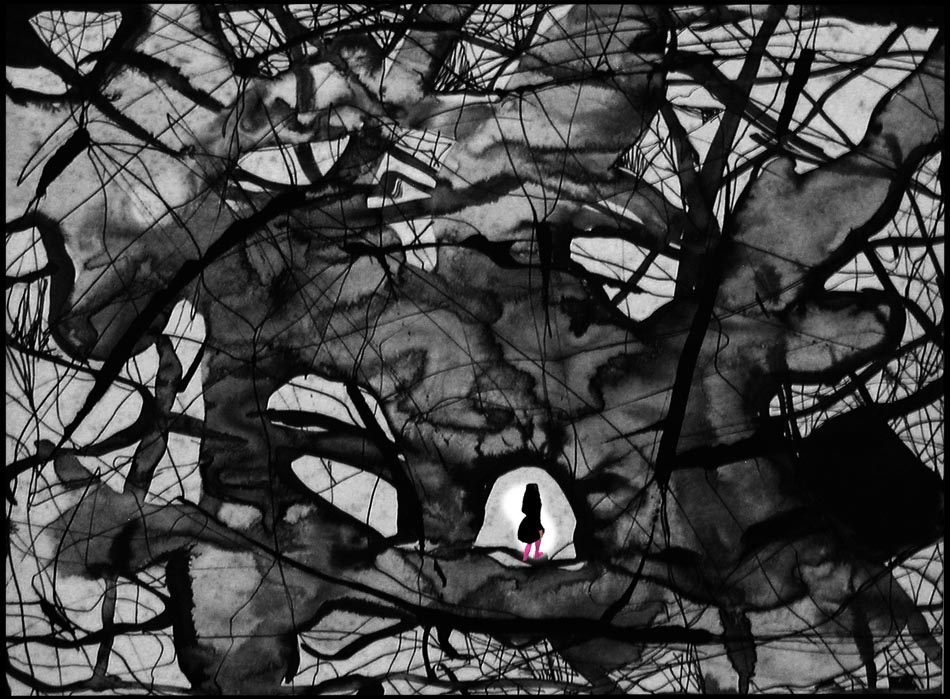
Should Kaidie use this map to plot her escape from her kidnapper in Second Life? After all it's been nearly 2 months since she's been there!
The following is one of several imaginary discussions between ‘Pro-First-Lifers’ (realists who value meatspace more than our virtual) and ‘Pro-Second-Lifers’ (cyber-enthusiasts and those who celebrate the power of imagination), in a fictitious online academic forum. Entitled (How) Does Physics Function In Cyberspace? Metaphysical Enquiries For The 21st Century: An Online Peer-To-Peer Peer-Reviewed Forum, subscribers include very serious philosophers, psychologists, media theorists, writers, cyber-geographers, cyber-artists, cyber-anthropologists and cyber-anybody-else. As in real life forums, participants are civilised – most of the time. Subscribers who identify themselves as a Pro-First-Lifer see Life 1.0 as the more important life, warn us of the dangers that lurk in Cyberspace, and view the Pro-Second Lifers as delusional dreamers who run away from problems they have in RL. Some of them also pelt names like ‘Stelarc Nutters’ and ‘Technogeeks’ at them. On the other hand, the pro-Second-Lifers retaliate by calling them names such as ‘Luddite’, ‘Academics who-are-pretend-Liberalists-but-are-actually-Fascists-in-real-life-Who-Diss-Everything-Because-It-Is-Uncool-Not-To’, ‘Conservatives’ and ‘Amish’. While many subscribers chose to hide behind generic avatars, some bravely use their real names (such as Sherry Turkle, Lev Manovich and Martin Heiddeger). That said, it is sometimes unclear which side they speak for. It is also suspected that some of the subscribers may have more than one account and speak from different sides. Such is the nature of any debates, especially online ones…
Let us begin our Cyberspace Odyssey.
Neal Stephenson: Like any place in Reality, the Street is subject to development. Developers can build their own small streets feeding off of the main one. They can build buildings, parks, signs, as well as things that do not exist in Reality, such as vast hovering overhead light shows and special neighbourhoods where the rules of three-dimensional spacetime are ignored.[1]
Pro-Second-Lifer A: This is an extraordinary time to be alive. Not only can I travel to different cities in real life (RL), there are even more travels I can have outside of RL. Thanks to the Internet, my world has expanded vastly. Cyberspace is a not only a great place to visit – within there, there are so many more places to enter. In Stephenson’s imagination, a metaverse is a ‘place’, with ‘streets’. In Gibson’s, it is a big neon ‘city’, within which there are many centres to visit. But the land size of Second Life alone, at 1,700 virtual square km, is larger than metropolitan London.[2] So it would not be a stretch, even, to describe Cyberspace as a world, within which there are yet many worlds to explore.
William Gibson: People jacked in so they could hustle. Put the trodes on and they were out there, all the data in the world stacked up like one big neon city, so you could cruise around and have a kind of grip of it, visually anyway, because if you didn’t, it was too complicated, trying to find your way to a particular piece of data you needed.[3]
Neal Stephenson: Hiro is approaching the Street. It is the Broadway, the Champs Elysees of the Metaverse. It is the brilliantly lit boulevard that can be seen, miniaturized and backward, reflected in the lenses of his goggles. It does not really exist. But right now, millions of people are walking up and down it.[4]
Pro-Second-Lifer B: Even when simply cruising around as Gibson does, surfing in cyberspace can be akin to psychogeographical tactic that the Situationists advocated in the streets. In these trips, surprises happen, bringing me to unexpected places. When I open my customised homepage on my Firefox browser, I may see a CNN news headlines that I click into to read; there, I may see comments written in by a viewer. Intrigued by her words, I check out her linked Blogspot blog. There, a Google ad pops up to tell me to check out a related topic, which I do, and at the same time, watch a Youtube posting by the same writer, at the same time! I write in a comment to her video, and seconds before I know it, someone else has already responded to my comment. So, another thing that makes my around-the-(Cyber)world-trip better than a RL one, is its simultaneity and real-time quality. It is as if I am visiting London, New York, Shanghai and Johannesburg at the same time! Better still, this world seems to be infinite, with no limits, capable of unending expansion. Like Columbus discovering virgin territories in the 15th century, Web 2.0 is our golden age of exploration, of Cyberspace. As not only a user but a content-creator myself with the easy-to-use tools, not only can I participate in the various virtual worlds, I can construct my own new territories.
Pro First-Lifer A: I might not have the guts to say this to you face–to-face, but I think you are being naïve, crass and Romantic. You are speaking of Cyberspace as if you are Alice entering Wonderland the first time, still in the state of enchantment. In the past two decades, the academic world has been up to speed with this – if not entire new departments like Informatics, there are new divisions in every discipline, such as digital anthropology or ethnography in the ‘old’ discipline of Anthropology, ‘new’ media art in Fine Art (which is by now rather old, so old that artists have dropped the ‘new’ out of embarrassment). This may disappoint you, but there is even the new discipline of Cybergeography – where geographers attempt to fully map the space that you describe as ‘infinite’. The same way psychoanalysts in Life 1.0 rationalise your dreams in your Life 2.0, Cybergeographers conduct their field work online, in-world, and share their data with us in Life 1.0. I am very sorry, but it is time to wake up from your (wet) dreams and have a reality check.
Martin Dodge and Rob Kitchin: The hype around much of Internet, especially in the mid 1990s, was that it was ‘everywhere and nowhere’ and it would make geography less significant in human organisation through the ‘death of distance’. This is patently not been the case. While the Internet has undoubtedly had an affect on the geography of business operation and individual consumption, distance is not dead. What is being witnessed is a complicated restructuring, through processes of concentration and decentralisation, across scales.[5]
Pro-Second-Lifer B: I do not disagree with Dr Dodge and Dr Kitchin. As we invent and use it, we also struggle to make sense of the complex medium. Just as we can approach life itself from different perspectives such as biology, religion and the arts, so, too, could Cyberspace be analysed from various ways. In fact, the penetration of the Internet on our lives is so far and deep, that it is as complex as life itself. And as Pro-First-Lifer 1 pointed out, pre-internet phenomena, disciplines and objects create neologisms, insert hyphens to join the new wave (e-commerce, iphone, Government 2.0); all offices, schools, libraries and institutions in First Life have an equal or even bigger Second Lives online (BBC’s iPlayer, tiny country Maldives as the first country to open its official embassy in Second Life in 2007[6]). Many brick-and-mortar businesses have also found it more efficient to have only virtual offices. So this is a complex stage of re-structuring and paradigm shifts indeed, as First Life attempts to be up to speed with the Second in Cyberspace, in order to fully make use of the powerful medium of the Internet.
Pro-First Lifer A: Check out my government’s website- on the page entitled ‘Social Media and Web 2.0 in Government’, the White House even has a tagline of ‘Better websites, better government’[7]! Recall too how part of Obama’s success during the election was because of his team’s ability to exploit the medium, being pervasive on Youtube and Twitter. So this is a case in point of an clever integration of our First and Second Lives.
Pro-Second –Lifer A: I’m confused though – should it not be the other way around? Better government, therefore better websites? … Anyways, let’s not digress from the discussion of the geography of Cyberspace that Dr Dodge and Dr Kitchin are trying to explain. In any case, no offence to Pro-First Lifer 1, but we certainly don’t need more of this country’s presence in our Second Lives, or of this country’s ‘exploitation’ of anything, for that matter, which we have in our First Lives. Way more than enough. Do not get me started.
Martin Dodge and Rob Kitchin: The idea of the Internet as being somehow ‘anti-geographical’ is based on three key notions: fantasy, denial, and ignorance: 1. Internet geography was assumed not to exist. This is anti-corporeal, cyber-utopianist fantasy that somehow the virtual communities of cyberspace can be produced in a realm divorced from material existence. 2. Internet geography was assumed not to be important, so could be denied. The failure of many e-commerce ventures in the dotcom boom, we would argue, was based in part on ignoring the grounded, geographic, realities of computer-mediated communication, logistic networks and labour markets. 3. Internet geography was assumed not be measurable. Because it was hard to do, it was ignored, especially in the heady days of bubble growth. The medium of communication might be virtual, but the Internet is dependent on physical infrastructure and human labour, most of which is invisible to users. The computers are small in scale and are usually hidden from view in anonymous servers rooms and secure, windowless buildings, while the cables are under floors, in ceilings and in conduits buried under roads. The banal technicalities of Internet infrastructures are easily overlooked (just like for other essential utilities of water, electricity) but they are not naturally given. The geographical structure and operation of networks that service modern living have politics.[8]
Pro-Second Lifer B: Dr Dodge, could you give an example please about the political nature of geography?
Martin Dodge: Domain names are important locational tools at a technical level, but also have a wider political geography in terms of how they are allocated and how this naming relates back to real-world territorial and jurisdictional boundaries. (For example, the recent ruling from a French court that the Yahoo Internet service must block users in France from buying Nazi memorabilia through the web.[9]
Pro-First-Lifer A: Just as there is geopolitics in the real world, there is cybergeopolitics as well. Let us discuss this in a later thread. Pro-Second Lifer 1, your Cyberbubble may burst if you come to my country and see Second Life’s 700 Debian Linux servers in a San Francisco data warehouse[10] – large, physical metals with lots of cables, all working furiously to generate your fantasy world. Just because you do not see them, you are blind also to their presence. And, by the way, if you do not already know, but this is a democratic society, so I have the right to free speech. Or, do you come from a repressed country with dismal human rights records? Have they blocked your Google search engine from the words ‘democracy’ and ‘freedom’ like the Chinese, or even ‘Life’ itself? Or, are you an oppressed Chinese yourself? I am a little busy saving the (real) world, but shall I liberate you as well?
John Perry Barlow: Whether by one telephonic tendril or millions, they are all connected to one another. Collectively, they form what their inhabitants call the Net. It extends across that immense region of electron states, microwaves, magnetic fields, light pulses and thought which sci-fi writer William Gibson named Cyberspace.[11]
Pro-Second Lifer A: The knowledge of the existence of hardworking machines running my Second Life in no way disrupts my enjoyment in-world. Incidentally, artist group Tsunami precisely attempted to question the meaning of distance in their presentation at Documenta 11, by walking from Kassel to Kiev, where Documenta’s servers are located.[12] Understanding that the workings of the dream machine of Hollywood studios, and for that matter, the behind-the-scenes of a blockbuster movie, can enhance my pleasure of the fictional world that is created. And even more so, arguably, in virtual worlds such as Second Life, since I am responsible for creating it! Like Pygmalion, can’t I help but marvel at my own creation! To return us to the topic of geography, I think it is a good idea to have a map around Cyberspace. GPS navigators, maps, Googlemaps and Google Earth certainly help and do not diminish the adventurer’s pleasure in her explorations. Magellan, with his crappy, low-tech compass (high tech at that time, to be sure), was the first to travel around the world, and went all the way to the Philippines (and got killed there, however, god bless his soul). In Cyberspace, search engines are already performing the function of helping one get oriented. Pro-First-Lifer A, answering you question, yes I am Chinese, but not that kind. What kind I am is none of your business. I think the Moderator of this forum should ‘liberate’ you and let you go. Like your country, you are uncivil. I must say that I find you repulsive.
John Perry Barlow: Cyberspace, in its present condition, has a lot in common with the 19th Century West. It is vast, unmapped, culturally and legally ambiguous, verbally terse (unless you happen to be a court stenographer), hard to get around in, and up for grabs. Large institutions already claim to own the place, but most of the actual natives are solitary and independent, sometimes to the point of sociopathy. It is, of course, a perfect breeding ground for both outlaws and new ideas about liberty.[13]
Bruce Sterling: Cyberspace is the ‘place’ where a telephone conversation appears to occur. Not inside your actual phone, the plastic device on your desk. Not inside the other person’s phone, in some other city. The place between the phones. […] [I]n the past twenty years, this electrical ‘space,’ which was once thin and dark and one-dimensional—little more than a narrow speaking-tube, stretching from phone to phone—has flung itself open like a gigantic jack-in the- box. Light has flooded upon it, the eerie light of the glowing computer screen. This dark electric netherworld has become a vast flowering electronic landscape. Since the 1960s, the world of the telephone has cross-bred itself with computers and television, and though there is still no substance to cyberspace, nothing you can handle, it has a strange kind of physicality now. It makes good sense today to talk of cyberspace as a place all its own[14].
Martin Dodge: [Cyberspace] suggests that we can exist in a digital ether. But these dreams are nowhere near reality, for cyberspace is hardly immaterial in that it is very much an embodied space. […] [I]t should be treated as an extension of the geographic realm, not as some disembodied, parallel universe. Nevertheless, cyberspace is changing geography, it is warping space, shrinking distance, and modifying our sense of place. Understanding these complex warpings and distortions is very much at the heart of cybergeography.[15]
Pro-Second Lifer B: Cyberspace, conceptualised in science-fiction of Life 2.0, is now brought back to the material world of Life 1.0 by Cybergeographers. While the realists or academics measure Life 2.0 with the rules of Life 1.0, Residents of Life 2.0 continue to attempt to push their limits of imagination and go deeper, further. While Dr Dodge maps Cyberspace as an ‘extension of the geographic realm’, Pro-Second Lifers like myself and Turkle’s MMOG player Doug would have mapped physical geography as an extension of Cyberspace, the same way he sees RL as another window in his desktop. In a similar vein, we can see our online existence as an extension of our physical existence, since many of us have email ‘addresses’ and ‘home’ pages, apart from an address and home in a physical location.
John Perry Barlow: Cyberspace is the homeland of the Information Age – the place where the citizens of the future are destined to dwell.[16]
Neal Stephenson: HIRO PROTAGONIST: Last of the freelance hackers/ Greatest sword fighter in the world/ Stringer, Central Intelligence Corporation / Specializing in software-related intel (music, movies & microcode). On the back is gibberish explaining how he may be reached: a telephone number. A universal voice phone locator code. A P.O. box. His address on half a dozen electronic communications nets. And an address in the Metaverse.[17]
Pro-Second-Lifer B: Like Stephenson’s Hiro Protagonist, our namecards can provide an address in the Metaverse rather than the physical – which in any case is becoming increasingly insignificant, given the death of the culture of letter-writing in preference of email (or briefer still, 140 characters). If we look at the larger picture, Cyberspace – not Earth – is our destined homeland, as Barlow tells us. Also, given that content is user-generated and emergent – by that I mean that which arises and exists only as a phenomenon of independent parts working together, and that which is not predictable on the basis of their properties[18] – there really seems to be more places that we can build, faster than the Cybergeographers are able to map them. The tension between Life 1.0 and Life 2.0 imaginations of the geography of Cyberspace is extremely interesting, just as the tension between Life 1.0 and Life 2.0 imaginations of of any aspect of life (identity, politics, behaviour, reality) and indeed, Life itself, extremely rich.
Pro-First-Lifer B: Pro-Second-Lifer B, you speak of the changes in Cyberspace as if human and natural geographies are static! In response to the changes in physical geography, new maps – and more importantly, new methods of thinking about mapping- are constantly generated. And, in this age, no one is so naïve as to assume that maps are transparent, neutral or objective, but are dynamic mappings.[19] Ditto Cyberspace! I also strongly advise you to have a look at Dr Dodge and Dr Kitchin’s wonderful book, Atlas of Cyberspace, which contains many mappings of many facets of Cyberspace, including maps of the structure of cyberspace, maps of the Web, maps of emails and virtual worlds, as well as an entire section of imaginations from the arts, including science fiction[20]. The existence of this book itself is proof enough of the Cybergeographers recognition of the diversity and wealth of Cyberspace.
Rob Kitchin and Martin Dodge: Maps are never fully formed and their work is never complete. Maps are transitory and fleeting, being contingent, relational and context-dependent; they are always mappings; spatial practices enacted to solve relational problems (eg, how best to create a spatial representation, how to understand a spatial distribution, how to get between A and B, and so on). [21]
Pro-Second-Lifer B: Thank you for the lead, I will definitely read that. I think we recognise that our quarrel about the gap between what we imagine (Life 2.0) and what we translate into reality (Life 1.0), belongs, in part, to the old debate of Cartesian anxiety. As a Pro-Second-Lifer, I certainly am in the ‘mind’ camp. Speaking of which, children certainly have very interesting imaginations of geography on- and off-line. Sherry Turkle talks about how children think of their creations in MMOGs coming to live, and travelling outside of their metaverse into cyberspace![22]
Sherry Turkle: Robbie, a 10-year-old who has been given a modem for her birthday, puts the emphasis not on communication but on mobility in considering whether the creatures she has evolved on SimLife are alive. […] if your modem were on, [the creatures] could get out of your computer and go to America Online. […] Sean, 13, who has never used a modem, comes up with a variant on Robbie’s ideas about travel. “The creatures could be more alive if they could get into DOS. If they were in DOS, they would be like a computer virus and they could get onto all of your disks, and if you loaned your disks to friends, it would be like they were travelling.”[23]
Pro-Second-Lifer A: And don’t we forget that it was, again, Google Earth – the powerful tool of military precision that raises concerns of privacy for the Pro-First-Lifers – is founded in science fiction as much as Jeremy Bentham’s panopticon. We don’t need to fly up the skies or outside of earth itself, to now have a bird’s or god’s eye view. Don’t we see the importance of Life 2.0, with its rich imaginations, supplying Life 1.0 with Life itself!
Neal Stephenson: There is something new: A globe about the size of a grapefruit, a perfectly detailed rendition of Planet Earth, hanging in space at arm’s length in front of his eyes. Hiro has heard about this but never seen it. It is a piece of CIC software called, simply, Earth. It is the user interface that CIC uses to keep track of every bit of spatial information that it owns — all the maps, weather data, architectural plans, and satellite surveillance stuff. [24]
Pro-Second-Lifer A: The MMOG Second Life begins as a vast landscape of untamed wilderness, that the Resident has to sculpt, shape, and settle. Just as RL, SL has different landscapes and sceneries for every taste and ambition – if one has enough Linden dollars, that is.
Wagner James Au: From open oceans spring sailboats, submarines, and cruise ships; from the plains come racing tracks, clothing–optional nightclubs, and Resident–made games of all size and style. From the mountains appears sprawling, Frank Lloyd Wright–style homes, tree villages, and heavily–armed World War II fortresses. In all this, there’s a distinct sense of an expanding wilderness being settled. [25]
Pro-First-Lifer A: You have a great sense of irony – the irony however is that you do not know it. You claim that ‘Life 2.0 supplying Life 1.0 with Life itself’ – do you not see that in your own formulation, Life 1.0 is the larger entity, with Life 2.0 a little grapefruit within it? And, my dear Pro-Second Lifer A, the ‘A’ in my avatar refers to my Almighty country, but I suppose yours refers to A***hole.
Moderator: Discussion thread closed due to Antagonistic behaviours of some users.
(This was sketched January 2010. Obviously, some things, including Kaidie’s grasp of things and her own position, have moved on. We are just uncertain if the ‘moving on’ is a progression, regression, or an other loopy trip).
[1] Neal Stephenson, Snow Crash (Spectra, 2000), pp. 24-25. (Chapter 4)
[2] Freund, Katie, ‘DIGC101 Online Worlds’, 2009 [accessed 2 January 2010].
[3] William Gibson, Mona Lisa Overdrive, (Spectra, 1989), p. 22.
[4] Stephenson, p. 24 (Chapter 1), Snow crash.
[5] Martin Dodge and Rob Kitchin, ‘Net: Geography Fieldwork: Frequently Asked Questions’, CASA: Working Paper Series, 83 (2004).
[6] ‘Tiny island nation opens the first real embassy in virtual world – Times Online’, Times Online, 2007 [accessed 22 December 2009].
[7] USA government, ‘Better websites. Better government: Social Media and Web 2.0 in Government’, WebContent.gov:, 2009 [accessed 4 January 2010].
[8] Dodge and Kitchin.
[9] Martin Dodge, ‘Cybergeography’, Environment and Planning B: Planning and Design 28(1) 1-2, 2001 [accessed 4 January 2010].
[10] Tim Guest, Second Lives (Arrow Books Ltd, 2008), p. 7.
[11] John Perry Barlow, Crime and Puzzlement, 1990. Quoted in Dodge, The Geography of Cyberspace Directory – What is Cyberspace ? [accessed 26 December 2009].
[12] Tilman Baumgartel, ‘[Reader-list] A different take on Documenta 11’ [accessed 4 January 2010].
[13] John Perry Barlow, Crime and Puzzlement, 1990. Quoted in Dodge, The Geography of Cyberspace Directory – What is Cyberspace? [accessed 26 December 2009].
[14] Bruce Sterling, Introduction to The Hacker Crackdown.
[15] Dodge 2001, ‘Cybergeography’, Environment and Planning B: Planning and Design 28(1) 1 – 2 .
[16] 1991, quoted in Dodge.
[17] Stephenson, Snow Crash.
[18] Apple Macintosh Dictionary function, version 2.0.3 (51.5).
[19] Rob Kitchin and Martin Dodge, ‘Rethinking maps’, Progress in Human Geography, 31 (2007), 331-344 [accessed 5 January 2010].
[20] Dodge and Kitchin.
[21] Rob Kitchin and Martin Dodge, ‘Rethinking maps’, Progress in Human Geography, 31 (2007), 331-344 [accessed 5 January 2010].
[22] Turkle, 4.01: Who Am We?
[23] Turkle, 4.01: Who Am We?
[24] Stephenson, Snow Crash. Chapter 13.
MEIFUMADO by M4SK 22, ‘INSPIRED BY A MEETING WITH SOMEONE WHO DOESN’T EXIST’. Thank you M4sk 22 for inspiring us with a lively and life-affirming work! Let’s keep running together.
Meifumadô by M4SK 22, April 2010.
IN THE WORDS OF M4SK 22:
‘Keep Running, Keep Dreaming, Keep Believing… Music and video by M4SK 22. Inspired by the selfless journey of Kaidie http://kaisyngtan.com/3rdlifekaidie. Footage from Princess Iron Fan, the first Chinese animated feature film, made by Wan Guchan and Wan Laiming (the Wan brothers) and released on January 1, 1941. The story was liberally adapted from a short sequence in the popular Chinese folk tale Journey to the West. Meifumadô (land of the demons) is also the title of the 5th Kozure ?kami (lone wolf and cub) film.’?
ABOUT M4SK 22:
M4SK 22, a sound and vision project by Simon Woolham and David Moss: ‘Artists making music with whatever we can get our hands on. Mixing acoustic and electric instruments roots, soils and dusts, samples and software, in a desire fired sonic crucible.’
Follow the work of M4SK 22 in Myspace, Blogspot, Twitter, Youtube and Vimeo.
19 APRIL MONDAY GMT 15:00 SLT 07:00: (RE)VISIT PHUKET WITH KAIDIE AND THE GOOD PIRATE (Kaidie’s Virtual Tourist Notes From Second Life #3)
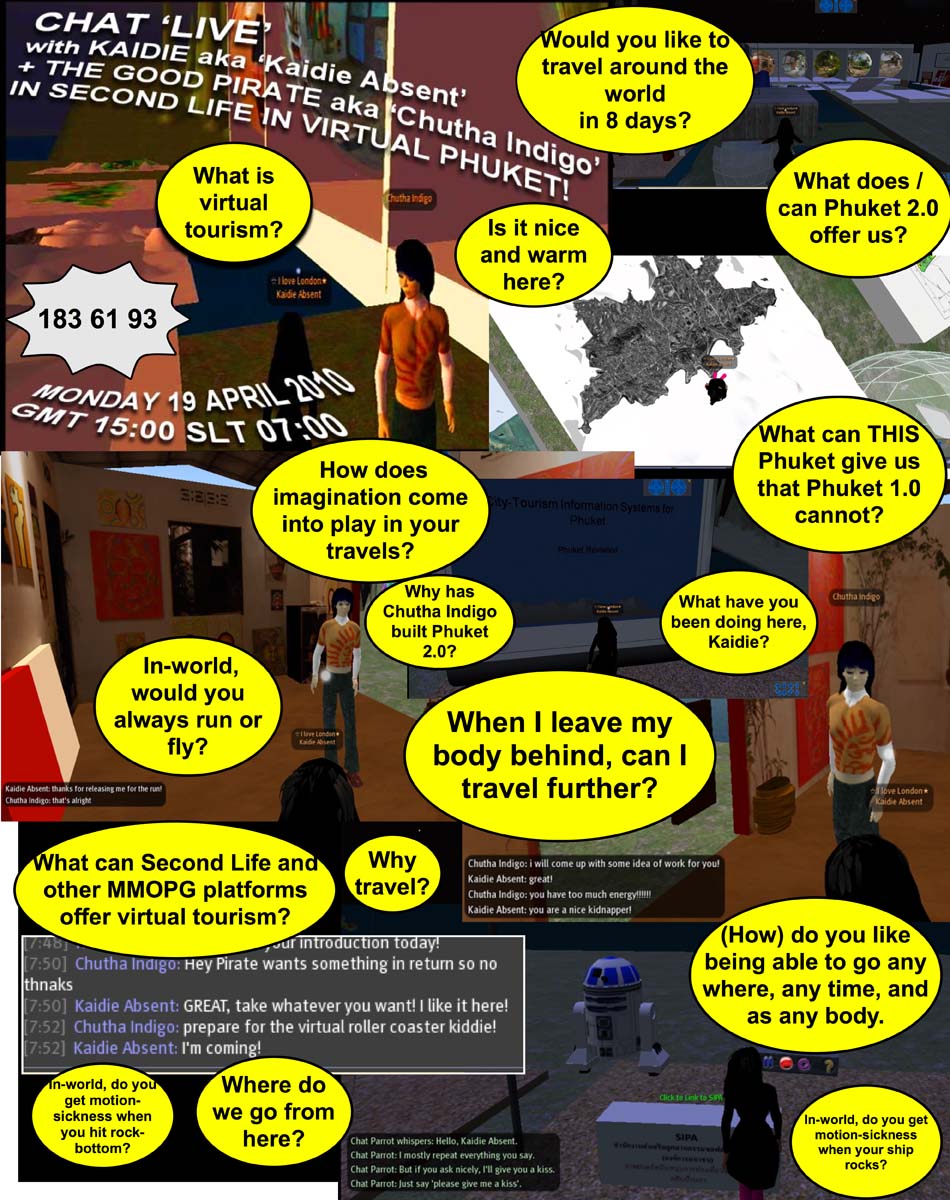 ABOUT THE GOOD PIRATE aka CHUTHA INDIGO aka CHUTHATIP ACHAVASMIT:
ABOUT THE GOOD PIRATE aka CHUTHA INDIGO aka CHUTHATIP ACHAVASMIT:
Chuthatip is a town planner at Department of Town and Country Planning (DTCP) in Thailand joining CASA in University College London as an Mphil/PhD. student in April 2004. She has a Bachelors Degree in Industrial Design from Chulalongkorn University, Thailand, a Masters of Urban and Regional Planning from VPI & SU, USA and a Professional Master Degree in Geoinformation Systems for Urban Management Application from ITC, the Netherlands. Chuthatip’s GI experience includes: utilising GIS in planning practice such as GIS-based planning methodology, integrating inter-organisation datasets for industrial pollution analysis and application for urban intensity calculation. Her interests are in Planning and Tourism, Digital City, Management of Geographic Information Infrastructure (GII). She is currently working on Urban Information System focusing on tourism in Phuket.
GETTING THERE:
1) You must first have Second Life installed on your computer. 2) Click here. (Location number 183 61 93) 3) Click the orange tab ‘teleport now’ on the popup window. 4) Allow website to open the program on your computer.?? OR 1) In SL, click tab ‘map’ on the lower bar, map window will pop up. 2) Enter or replace location numbers to ‘183 61 93′ 3) Click ‘teleport’. * When you reach there, you have to fly vertically up! Virtual Phuket is floating! To ensure that you get there, there, simply add ‘KAIDIE ABSENT’ and/or ‘CHUTHA INDIGO’ as your friend!
**** BREAKING NEWS: 19 APRIL MAY BE THE LAST DAY OF THE EXISTENCE OF VIRTUAL PHUKET!! SO, PLEASE DO COME BY!!****
A month ago, during Kaidie’s dislocation, she was momentarily located in a Singapore newspaper in Life 1.0 (printed edition) and Life 2.0 (online version), and Life 3.0 (somewhere in between).
The above is reproduced and cropped from Today Online 23 March 2010, Mediacorp, Singapore.
** ERRATUM: Kaidie is not an artist. She is a (re-)searcher for the Meaning of Life 3.0. Now THAT’A a FULLTIME AND NOBLE (pre-)occupation!**
KAIDIE’S HITS/MISSES: IF WE CAN’T/DON’T WANT TO MEET IN THIS LIFE, PERHAPS WE COULD IN OUR NEXT/OTHER LIVES. ASSUMING THAT YOU’D LIKE TO, THAT IS. Same place, same time?
 Reprinted from Facebook posts by Meena Mylvaganam, Marta Sofia Pinho Alves and Urbantick/Fabian Neuhaus. Image by Urbantick/Fabian Neuhaus.
Reprinted from Facebook posts by Meena Mylvaganam, Marta Sofia Pinho Alves and Urbantick/Fabian Neuhaus. Image by Urbantick/Fabian Neuhaus.
UPDATABLE GLOSSARY (ongoing): IMITATIONS OF LIFE
SEEKING DEFINITIONS AND MULTIPLE+ALTERNATIVE DEFINITIONS! CONTRIBUTE NOW!
VARIATIONS OF LIFE:
* Life:
* This Life:
* Any Life:
* Any difference:
* What life?:
* What, life?:
* Best life:
* ‘Best’ life:
* Best ‘life’:
* Least worst life:
* Meaningful life:
* Less meaningless life:
* Life 1.0 / First Life:
* Life 2.0 / Second Life:
* Life 3.0 / Third Life:
* Turd Life:
* After life:
* After lives:
* Life before this life:
* Non-Life:
* Life after death:
* Life before death:
* Life during death:
* Lives after death:
* Death during life:
* Deaths during life:
* Living death
* Living hell
* Living:
* What living:
* Living thing:
* Living person:
* Running:
* Running for (y)our life:
* Run of (y)our life time:
* Run of (y)our life times:
* Travel:
* Travelling:
* Journey of life:
* Journeys of life:
* Journey of lives:
* Semblance of life:
* Imitation of life:
* Variations of life:
* Pseudo-life:
* Semi-life:
* Quasi-life:
* Life style:
* Way of life:
* Ways of life:
* Existence:
* Non-existence:
* Being:
* Non-being:
* Ontology:
* Life-and-death:
* Lives-and-deaths:
* Hanging on to dear life:
* Dignified death:
* Dignified deaths:
* Life-span:
* Life-spans:
* Fate:
* Fates:
* Destiny:
* Destination:
* Anti-destiny:
* Anti-fate:
* There is no such bloody things as fate/destiny:
* Getting there:
* There there:
* Getting there there:
* Don’t be silly, for there is no there there (Gertrude Stein):
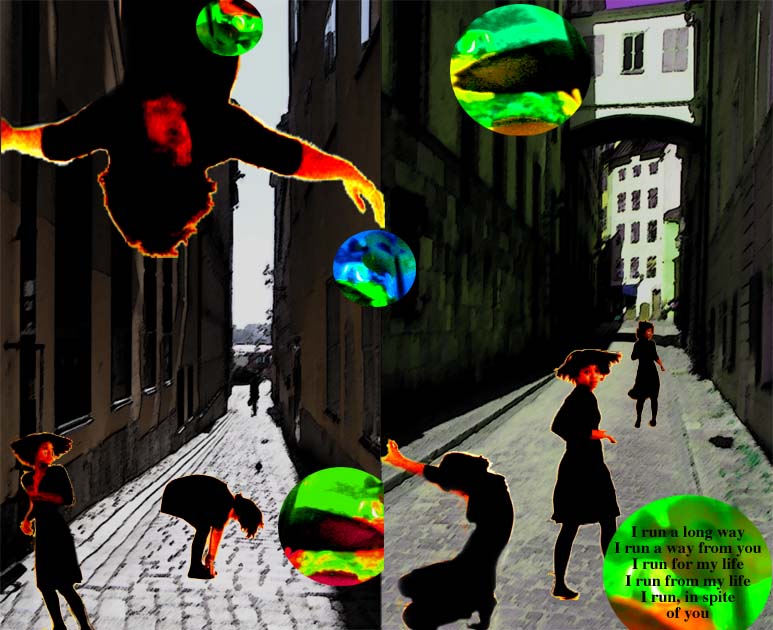
I run, because of you, of course not because of you, in spite of you, with you, with out you, regard less, I run, on and on, like the vapid Energizer bunny who goes on and on, but with blisters and aches, like the other vapid Energizer-bunny of Sisyphus with his endless rocks-and-rolls, in drips and drops, in laps and loops, sometimes limping, more often than not swearing, not in leaps and bounds, often falling, often bruising, often idiotic-looking, often idiotic, period, in turns, by turns, again and again, once more, repeat play, next level, same level, drop level, don't stop, can't stop, won't stop, don't ask me to stop, can't go on, must go on, won't go on, don't go on, go on, go on then, come on, don't talk to me when I'm running, running, even if slowly, even as if walking, even as if crawling, as if dead, even when/especially when panting, panting hard, sometimes holding my breath, some times not breathing, for fun, some times choking, invariably grunting, like an gnat, if gnats grunt, or screeching, like an eel about to be slaughtered, so that I can swallow it with jelly, cold, or heated, because jellied eel is one of my favourite foods in Nondon (along with beetroot and parsnips), and eels as unagi some place else in an other time and space (whether it knows of its parallel existence or not), if eels screech, at all, as if eels screeched, at all, wiping off my sweat, unsure if I felt hot or cold, or hot and cold at the same time, sun shining while temperatures are near zero, violent juxtapositions, the way I like it, run, running, why does one run? Just because. Because running takes me where I can not other wise go, for better or worse, like it or not, take it or leave it. Because it makes me happy. Because it makes me less unhappy. Because why not. Running, because why not. Because why the hell not. For, what else is there to do. What else can I do. For how long should I do it. Assuming that one has to do some thing, that is. Is that? Bad answer. Bad question, that's why. Refine your question. Change your question. What was your question? Was it a question? Did you have a question? Restart (if you so wish to). All over. Again.
IN THE METAVERSE, NO ICARUS WILL CRASH. Even if/when I crash, I will be reborn and life goes on. And on. Infinitely. Ad nauseum.
A generation cushioned from the cold by central heating, from the heat by airconditioning, carted in aseptic transports from one identical house or hotel to the another, should feel the need for journeys of mind and body, for pep pills or tranquillisers, or for the cathartic journeys of sex, music and dance. We spend far too much time in shuttered rooms.
– Bruce Chatwin, Anatomy of Restlessness: Selected Writings 1969 – 1989 [1]
Travelling is the act of getting from one place to another[2]. There has been a long history of human movement. Motivations vary – people travel out of pleasure, or reasons political , economical and poetic, or out of necessity, for short or long term, due to push or pull factors, and in various modes of transportation as technologies improve and ambitions engorge. Think climate changes, agricultural practices, trade, migration, famines. Think nomads, gypsies, sailors, stateless people and their diasporas. Think political conquests, search for new, virgin territories, untapped resources, ‘discoveries’ of ‘new’ continents like your Americas and Temasek-s[3]. Think of the revolutionary heroes, as writer, romantic and compulsive traveller Chatwin urges, who are ‘not worth a thing until he has been on a good walk. Che Guevara spoke of the “nomadic phase” of the Cuban Revolution. Look what the Long March did for Mao TseTung, or Exodus for Moses.’[4] Think escape and the search for Paradise, by Thelma, Louise, and Gauguin, and the middle-aged European/Australian woman in Bali with the Kuta cowboys, and the modestly-sized Oriental man with the towering platinum-blonde escort. Think religious pilgrimages, rites of passage and existential quests for the meaning of life. Think Romantic, heroic and punishing quests by madmen Fitzcarraldo/Klaus Kinski in the Amazon, and the solo walks from Kiev to Madrid by Werner Herzog himself, as if the very act of a strenuous trek exorcises their demons. Think trade shows, World Expos, and the travelling circus in town. Think Grand Tours to see the world for those with the leisure time (for it did take a bit longer than it would today) and spending power. For those with even more spending power, think travels to outer space, as the guy appropriately named Laliberte did in 2009 – something technologically impossible only years ago, but haunted those rich in imagination for centuries, like George Melies and Arthur C. Clark. Think poetic search for inspirations and new ways of seeing, by Barthes in Japan, and Basho the poet who cured himself of his loneliness by islandhopping in Japan. As Chatwin observes,
travel does not merely broaden the mind. It makes the mind, The raw materials of Proust’s imagination were two walks round the town of Illiers where he spent his family holidays. These walks later became Méséglise and Guermantes Ways in À la Recherche du Temps Perdu. [5]
Chatwin notes also that ‘(m)an walked and swam long before he rode or flew. Our human possibilities are best fulfilled on land or sea. Poor Icarus crashed.’[6]. Think Maldives, Goa, Ibiza. Entire cities and towns perform. Today, globalisation and 1-pence early-bird gimmicks from budget airlines gives everyone the opportunity to fly, making travelling a part of contemporary life. We become tourists, take breaks, have getaways, go for vacations, perform public sex on the beach with strangers [7] in the city constructed for public show-and-tell. Think casino-city Macau, Documenta in Kassel once every 5 years, Olympics in London in 2012. Then, there are also those who travel simply because the act of travelling is pleasurable in itself, like ‘the indefatigable Arab wanderer who strolled from Tangier to China and back for the sake of it’ [8].
Some American brain specialists took encephalograh reading of travellers. They found that changes of scenery and awareness of the passage of seasons trough the year stimulated the rhythms of the brain, contributing to a sense of wellbeing and an active purpose in life. Monotonous surroundings and tedious regular activities wove patterns which produce fatigue, nervous disorders, apathy, self-disgust and violent reactions.
– Chatwin[9]
[1] Bruce Chatwin, Anatomy of Restlessness: Uncollected Writings, New edition (Picador, 1997). (pp 100-106)
[2] ‘Travel – Definition of travel noun’, in (Cambridge Dictionary Online: Free English Dictionary and Thesaurus, 2009) [accessed 30 December 2009].
[3] Temasek was the ancient name of Singapore before its ‘founding’ by the British.
[4] Chatwin.
[5] Chatwin.
[6] Chatwin.
[7] John Bingham and Laura Clout, ‘British couple arrested in Dubai over ‘sex on the beach’’, Telegraph.co.uk, 9 July 2008 [accessed 31 December 2009].
[8] Chatwin.
[9] Chatwin.



